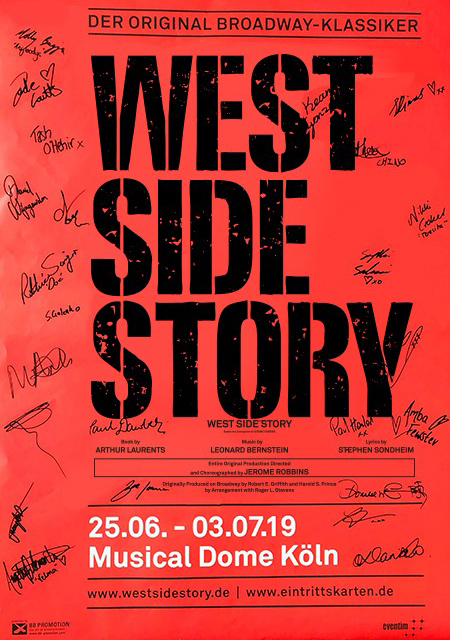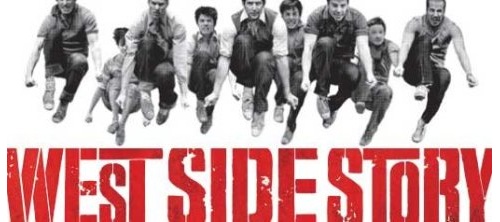
Située dans le New York du milieu des années 1950, l'intrigue cible surtout la rivalité entre Jets et Sharks, deux bandes de jeunes des bas-quartiers, pour le monopole du territoire. Les Sharks appartiennent à la première génération d'Américains émigrés de Porto Rico. Ils sont raillés par les Jets, jeunes de la classe ouvrière blanche qui se considèrent comme les véritables Américains car nés en Amérique, même si de parents eux-mêmes émigrés, qui d'Irlande ou de Suède ou encore de Pologne. Tony, amis du chef des Jets Riff, rencontre Maria, la sœur de Bernardo, chef des Sharks. Ils tombent amoureux pour le meilleur et le pire.
Acte I
Deux bandes rivales d'adolescents, les Jets (américains) et les Sharks (migrants portoricains), se disputent le contrôle d'un quartier new-yorkais, au milieu des sifflets et des railleries des policiers (Danse du Prologue). Les Jets s'écartent pour faire la fête de leur côté et se concertent pour trouver un moyen de conserver leur domination sur la rue (Chanson des Jets). Leur chef, Riff, convainc son ami Tony, de les rejoindre au bal du quartier. Fidèle à Riff, Tony acquiesce mais il n'est pas heureux de la vie en bande et imagine un futur meilleur (Something's Coming). Maria travaille dans un magasin de robes de mariées avec Anita, la petite amie de son frère, Bernardo, qui est le chef des Sharks. La famille de Maria a choisi Chino pour être son futur mari. Maria est nouvellement arrivée du Porto Rico et, comme Tony, est pleine d'espoir. Anita confectionne une robe pour Maria qu'elle portera au bal du quartier.
Au bal, après les présentations, les jeunes gens commencent à danser. Bientôt commence une danse de défi (Mambo). Tony et Maria s'aperçoivent à travers la salle et se sentent mutuellement attirés. Ils dansent ensemble, oubliant la tension régnant dans la salle, et tombent amoureux. Bernardo exaspéré enlève sa sœur des bras de Tony et l'envoie à la maison. Riff et Bernardo se mettent d'accord pour se retrouver pour un « conseil de guerre » dans l'arrière-boutique du Doc, considérée comme terrain neutre. Tony, épris et heureux, cherche l'immeuble de Maria pour chanter une sérénade sous ses fenêtres (Maria). Maria apparaît alors sur l'escalier de secours, et les deux jeunes gens s'avouent leur amour (Tonight). Pendant ce temps, Anita et les autres filles des Sharks évoquent les différences entre Porto Rico et l'Amérique (America). Chez le Doc, l'anxiété monte parmi les Jets qui attendent les Sharks (Cool). Les Sharks arrivent, et après une interruption de l'inefficace lieutenant. Schrank, ils conviennent que Bernardo se battra contre Diesel. Tony suggère les poings, mais ce sont les armes qui sont choisies. En dépit des avertissements de Doc., Tony est convaincu que rien ne peut arriver de grave ; il est amoureux.
Tony retrouve Maria au magasin le jour suivant, où ils rêvent de leur mariage (One Hand, One Heart). Elle demande à Tony d'empêcher le combat. Il promet. Tony, Maria, Anita, Bernardo (et les Sharks), et Riff (et les Jets), tous évoquent chacun de leur côté les événements de cette nuit (Tonight Quintet). Tony arrive et essaye d'arrêter la bagarre qui a déjà commencé. Mais Bernardo raille Tony, ridiculise sa tentative de faire la paix et le provoque de toutes les manières alors que Tony conserve son calme. Au milieu de la bagarre, Riff et Bernardo se battent au couteau. Tony conjure Riff de s'écarter, mais Riff s'en débarrasse et continue le combat. Bernardo poignarde Riff. En réaction, Tony tue Bernardo dans un excès de fureur. Le bruit des sirènes se rapproche, et tout le monde se disperse, excepté Tony, choqué par ce qu'il a fait. Au dernier moment, Anybodys, un garçon manqué, qui espère devenir un Jet, indique à Tony le moyen de se sauver. Seuls restent les corps de Riff et de Bernardo.
Acte II
Avec ses amies, Maria n'a pas entendu les nouvelles et rêve éveillée heureuse d'être aimée par Tony (I Feel Pretty). Elle évoque le mariage, mais les filles croient qu'elle pense à Chino. Chino arrive alors et annonce que Tony a tué Bernardo, et jure qu'il le lui fera payer. Après leur départ, Tony grimpe par la fenêtre de Maria et la trouve en prière. Il explique ce qui s'est passé et demande son pardon. Maria et Tony imaginent un monde meilleur où ils pourront s'aimer, et où les Jets et les Sharks pourront vivre ensemble dans la paix et l'harmonie (Somewhere). Ils s'embrassent sur le lit de Maria. Pendant ce temps, le policier Krupke interroge les Jets au sujet des meurtres. La bande se moque de Krupke et des autres adultes (assistants sociaux, police, psychiatres et juges), qui ne les comprennent pas (Gee, Officer Krupke).
Anita effondrée arrive chez Maria. Tony s'échappe par la fenêtre, demandant à Maria de le retrouver chez le Doc d'où ils pourront s'enfuir au loin. Anita se rend compte que Tony était avec Maria, et demande avec horreur comment elle peut aimer l'homme qui a tué son frère (A Boy Like That). Maria répond passionnément (I Have A Love), et Anita comprend que Maria aime Tony autant qu'elle-même a aimé Bernardo. Elle avoue que Chino a un revolver et recherche Tony. Schrank arrive pour interroger Maria, et Anita accepte à contrecœur d'aller chez le Doc pour demander à Tony d'attendre.
Au magasin, les Jets raillent Anita avec des insinuations et des insultes racistes. Les moqueries se transforment en agression physique, et Anita est violentée avant que Doc horrifié n'arrive pour arrêter les garçons. Dans sa colère, Anita hurle aux Jets que Bernardo avait raison à leur sujet et ment en disant que Chino a tué Maria. Après avoir calmé les Jets, le Doc relate la nouvelle à Tony, qui faisait les cent pas dans la cave du Doc en rêvant de s'installer à la campagne et d'avoir des enfants avec Maria. Doc lui apprend la triste nouvelle (sans savoir que c'est un mensonge défensif d'Anita). Sentant que plus rien ne vaut de vivre, Tony part chercher Chino priant pour que Chino le tue aussi. Au moment où Tony s'aperçoit que Maria est vivante, Chino arrive et le tue. Pendant que Tony meurt dans les bras de Maria, les Jets et les Sharks se rassemblent autour des amoureux (Somewhere, reprise). Maria prend le revolver de Chino et leur dit que c'est la haine qui a tué Tony et les autres, maintenant elle peut les tuer, parce qu'elle les hait aussi. Mais elle est incapable de tirer et s'effondre dans sa douleur, mettant fin au cycle de la violence. Les adultes sont arrivés trop tard pour empêcher les coups de feu. Progressivement, les membres des deux bandes se réunissent de chaque côté du corps de Tony, proposant de mettre fin à jamais à leur inimitié. Les Jets et les Sharks forment un cortège et ensemble ils portent le corps de Tony. Krupke arrête Chino.
Inspiré de la tragédie Roméo et Juliette de William Shakespeare
Genesis of the concept
In 1947, Jerome Robbins approached Leonard Bernstein and Arthur Laurents about collaborating on a contemporary musical adaptation of Romeo and Juliet. He proposed that the plot focus on the conflict between an Irish American Roman Catholic family and a Jewish family living on the Lower East Side of Manhattan, during the Easter–Passover season. The girl has survived the Holocaust and emigrated from Israel; the conflict was to be centered around anti-Semitism of the Catholic "Jets" towards the Jewish "Emeralds" (a name that made its way into the script as a reference). Eager to write his first musical, Laurents immediately agreed. Bernstein wanted to present the material in operatic form, but Robbins and Laurents resisted the suggestion. They described the project as "lyric theatre", and Laurents wrote a first draft he called East Side Story. Only after he completed it did the group realize it was little more than a musicalization of themes that had already been covered in plays like Abie's Irish Rose. When he opted to drop out, the three men went their separate ways, and the piece was shelved for almost five years.
In 1955, theatrical producer Martin Gabel was working on a stage adaptation of the James M. Cain novel Serenade, about an opera singer who comes to the realization he is homosexual, and he invited Laurents to write the book. Laurents accepted and suggested Bernstein and Robbins join the creative team. Robbins felt if the three were going to join forces, they should return to East Side Story, and Bernstein agreed. Laurents, however, was committed to Gabel, who introduced him to the young composer/lyricist Stephen Sondheim. Sondheim auditioned by playing the score for Saturday Night, his musical that was scheduled to open in the fall. Laurents liked the lyrics but was not impressed with the music. Sondheim did not care for Laurents' opinion. Serenade ultimately was shelved.
Laurents was soon hired to write the screenplay for a remake of the 1934 Greta Garbo film The Painted Veil for Ava Gardner. While in Hollywood, he contacted Bernstein, who was in town conducting at the Hollywood Bowl. The two met at the Beverly Hills Hotel, and the conversation turned to juvenile delinquent gangs, a fairly recent social phenomenon that had received major coverage on the front pages of the morning newspapers due to a Chicano turf war. Bernstein suggested they rework East Side Story and set it in Los Angeles, but Laurents felt he was more familiar with Puerto Ricans and Harlem than he was with Mexican Americans and Olvera Street. The two contacted Robbins, who was enthusiastic about a musical with a Latin beat. He arrived in Hollywood to choreograph the dance sequences for The King and I, and he and Laurents began developing the musical while working on their respective projects, keeping in touch with Bernstein, who had returned to New York. When the producer of The Painted Veil replaced Gardner with Eleanor Parker and asked Laurents to revise his script with her in mind, he backed out of the film, freeing him to devote all his time to the stage musical.
Collaboration and developmentIn New York, Laurents went to the opening night party for a new play by Ugo Betti, and there he met Sondheim, who had heard that East Side Story, now retitled West Side Story, was back on track. Bernstein had decided he needed to concentrate solely on the music, and he and Robbins had invited Betty Comden and Adolph Green to write the lyrics, but the team opted to work on Peter Pan instead. Laurents asked Sondheim if he would be interested in tackling the task. Initially he resisted, because he was determined to write the full score for his next project (Saturday Night had been aborted), but Oscar Hammerstein convinced him that he would benefit from the experience, and he accepted. Meanwhile, Laurents had written a new draft of the book changing the characters' backgrounds: Anton, once an Irish American, was now of Polish and Irish descent, and the formerly Jewish Maria had become a Puerto Rican.
The original book Laurents wrote closely adhered to Romeo and Juliet, but the characters based on Rosaline and the parents of the doomed lovers were eliminated early on. Later the scenes related to Juliet's faking her death and committing suicide also were deleted. Language posed a problem; four-letter curse words were uncommon in the theatre at the time, and slang expressions were avoided for fear they would be dated by the time the production opened. Laurents ultimately invented what sounded like real street talk but actually was not: "cut the frabba-jabba", for example.[12] Sondheim converted long passages of dialogue, and sometimes just a simple phrase like "A boy like that would kill your brother", into lyrics. With the help of Oscar Hammerstein, Laurents convinced Bernstein and Sondheim to move "One Hand, One Heart", which he considered too pristine for the balcony scene, to the scene set in the bridal shop, and as a result "Tonight" was written to replace it. Laurents felt that the building tension needed to be alleviated in order to increase the impact of the play's tragic outcome, so comic relief in the form of Officer Krupke was added to the second act. He was outvoted on other issues: he felt the lyrics to "America" and "I Feel Pretty" were too witty for the characters singing them, but they stayed in the score and proved to be audience favorites. Another song, "Kid Stuff", was added and quickly removed during the Washington, D.C. tryout when Laurents convinced the others it was helping tip the balance of the show into typical musical comedy.
Bernstein composed West Side Story and Candide concurrently, which led to some switches of material between the two works. Tony and Maria's duet, "One Hand, One Heart", was originally intended for Cunegonde in Candide. The music of "Gee, Officer Krupke" was pulled from the Venice scene in Candide. Laurents explained the style that the creative team finally decided on: "Just as Tony and Maria, our Romeo and Juliet, set themselves apart from the other kids by their love, so we have tried to set them even further apart by their language, their songs, their movement. Wherever possible in the show, we have tried to heighten emotion or to articulate inarticulate adolescence through music, song or dance."
The show was nearly complete in the fall of 1956, but almost everyone on the creative team needed to fulfill other commitments first. Robbins was involved with Bells Are Ringing, then Bernstein with Candide, and in January 1957 A Clearing in the Woods, Laurents' latest play, opened and quickly closed. When a backers' audition failed to raise any money for West Side Story late in the spring of 1957, only two months before the show was to begin rehearsals, producer Cheryl Crawford pulled out of the project. Every other producer had already turned down the show, deeming it too dark and depressing. Bernstein was despondent, but Sondheim convinced his friend Hal Prince, who was in Boston overseeing the out-of-town tryout of the new George Abbott musical New Girl in Town, to read the script. He liked it but decided to ask Abbott, his longtime mentor, for his opinion, and Abbott advised him to turn it down. Prince, aware that Abbott was the primary reason New Girl was in trouble, decided to ignore him, and he and his producing partner Robert Griffith flew to New York to hear the score.[19] In his memoirs, Prince recalled, "Sondheim and Bernstein sat at the piano playing through the music, and soon I was singing along with them."
Production period
Prince began cutting the budget and raising money. Robbins then announced he did not want to choreograph the show, but changed his mind when Prince agreed to an eight-week dance rehearsal period (instead of the customary four), since there was to be more dancing in West Side Story than in any previous Broadway show, and allowed Robbins to hire Peter Gennaro as his assistant.[20] Originally, when considering the cast, Laurents wanted James Dean for the lead role of Tony, but the actor had died before hearing of it. Sondheim found Larry Kert and Chita Rivera, who created the roles of Tony and Anita, respectively. Getting the work on stage was still not easy. Bernstein told Rolling Stone: "Everyone told us that [West Side Story] was an impossible project ... And we were told no one was going to be able to sing augmented fourths, as with "Ma-ri-a" ... Also, they said the score was too rangy for pop music ... Besides, who wanted to see a show in which the first-act curtain comes down on two dead bodies lying on the stage?... And then we had the really tough problem of casting it, because the characters had to be able not only to sing but dance and act and be taken for teenagers. Ultimately, some of the cast were teenagers, some were 21, some were 30 but looked 16. Some were wonderful singers but couldn't dance very well, or vice versa ... and if they could do both, they couldn't act."
Throughout the rehearsal period, the New York newspapers were filled with articles about gang warfare, keeping the show's plot timely. Robbins kept the cast members playing the Sharks and the Jets separate in order to discourage them from socializing with each other and reminded everyone of the reality of gang violence by posting news stories on the bulletin board backstage. Robbins wanted a gritty realism from his sneaker- and jeans-clad cast. He gave the ensemble more freedom than Broadway dancers had previously been given to interpret their roles, and the dancers were thrilled to be treated like actors instead of just choreographed bodies. As the rehearsals wore on, Bernstein fought to keep his score together, as other members of the team called on him to cut out more and more of the sweeping or complex "operatic" passages. Columbia Records initially declined to record the cast album, saying the score was too depressing and too difficult.
There were problems with Oliver Smith's designs. His painted backdrops were stunning, but the sets were, for the most part, either shabby looking or too stylized. Prince refused to spend money on new construction, and Smith was obliged to improve what he had as best he could with very little money to do it.
The pre-Broadway run in Washington, D.C. was a critical and commercial success, although none of the reviews mentioned Sondheim, listed as co-lyricist, who was overshadowed by the better-known Bernstein. Bernstein magnanimously removed his name as co-author of the lyrics, although Sondheim was uncertain he wanted to receive sole credit for what he considered to be overly florid contributions by Bernstein. Robbins demanded and received a "Conceived by" credit, and used it to justify his making major decisions regarding changes in the show without consulting the others. As a result, by opening night on Broadway, none of his collaborators were talking to him.
It has been rumored that while Bernstein was off trying to fix the musical Candide, Sondheim wrote some of the music for West Side Story, and that Bernstein's co-lyricist billing mysteriously disappeared from the credits of West Side Story during the tryout, presumably as a trade-off. However, Suskin states in Show Tunes that "As the writing progressed and the extent of Bernstein's lyric contributions became less, the composer agreed to rescind his credit...Contrary to rumor, Sondheim did not write music for the show; his only contribution came on "Something's Coming", where he developed the main strain of the chorus from music Bernstein wrote for the verse.)
Original Broadway production
After auditions in Washington, D.C. and Philadelphia beginning in August 1957, the original Broadway production opened at the Winter Garden Theatre on September 26, 1957 to positive reviews. The production was directed and choreographed by Jerome Robbins, produced by Robert E. Griffith and Harold Prince and starred Larry Kert as Tony, Carol Lawrence as Maria, Chita Rivera as Anita and David Winters as Baby John, the youngest of the gang members. Robbins won the Tony Award for Best Choreographer, and Oliver Smith won the Tony for Best Scenic Designer. Also nominated were Carol Lawrence, as Best Actress in a Supporting Role in a Musical, Max Goberman as Best Musical Director and Conductor, and Irene Sharaff for Best Costume Design. Carol Lawrence received the 1958 Theatre World Award. Lighting was designed by Jean Rosenthal. The production ran for 732 performances at the Winter Garden Theatre before touring and then returning to the Winter Garden Theatre in 1960 for another 253 performance engagement.
The other principal or notable cast members in the original production were: Anybodys: Lee Becker, Riff: Michael Callan, A-Rab: Tony Mordente, Action: Eddie Roll, Big Deal: Martin Charnin, Gee-Tar: Tommy Abbott; Velma: Carole D'Andrea, Bernardo: Ken Le Roy, Chino: Jamie Sanchez, Nibbles: Ronnie Lee; Rosalia: Marilyn Cooper, Consuelo: Reri Grist, Teresita: Carmen Gutierrez, Francisca: Elizabeth Taylor; Lt. Schrank: Arch Johnson, Doc: Art Smith, and Krupke: William Bramley.
Original London production
The 1958 European premiere at the Manchester Opera House transferred to London, where it opened at Her Majesty's Theatre in the West End on Friday December 12, 1958 and ran until June 1961 with a total of 1,039 performances. Robbins directed and choreographed, and it was co-choreographed by Peter Gennaro, with scenery by Oliver Smith. Featured performers were George Chakiris, who won an Academy Award as Bernardo in the 1961 film version, as Riff, Marlys Watters as Maria, Don McKay as Tony, and Chita Rivera reprising her Broadway role as Anita. David Holliday, who had been playing Gladhand since the London opening, took over as Tony, playing opposite Roberta D'Esti's Maria, and Mary Preston as Anita.
In February 1962, the West End (H. M. Tennent) production launched a five-month Scandinavian tour opening in Copenhagen, continuing to Oslo, Goteborg, Stockholm and Helsinki. Robert Jeffrey took over from David Holliday as Tony and Jill Martin played Maria.
1980 Broadway revival
A Broadway revival opened at the Minskoff Theatre on February 14, 1980 and closed on November 30, 1980, after 333 performances. It was directed and choreographed by Robbins, with the book scenes co-directed by Gerald Freedman; Tom Abbott and Lee Becker Theodore assisted the choreography reproduction. The original scenic, lighting, and costume designs were used. It starred Ken Marshall as Tony, Hector Jamie Mercado as Bernardo, Josie de Guzman as Maria, and Debbie Allen as Anita. Both de Guzman and Allen received Tony Award nominations as Best Featured Actress in a Musical, and the musical was nominated as Best Reproduction (Play or Musical). Allen won the Drama Desk Award as Outstanding Featured Actress in a Musical. Other notable cast members in the revival included Brent Barrett as Diesel, Harolyn Blackwell as Francisca, Stephen Bogardus as Mouth Piece, Reed Jones as Big Deal, and Sammy Smith as Doc.
Several dances from West Side Story were included in the Tony Award-winning 1989 Broadway production, Jerome Robbins' Broadway.
2009 Broadway revival
In 2007, Arthur Laurents stated, "I've come up with a way of doing [West Side Story] that will make it absolutely contemporary without changing a word or a note." He directed a pre-Broadway production of West Side Story at the National Theatre in Washington, D.C. that ran from December 15, 2008 through January 17, 2009. The Broadway revival began previews at the Palace Theatre on February 23, 2009 and opened on March 19, 2009. The production wove Spanish lyrics and dialogue into the English libretto. The translations are by Tony Award winner Lin-Manuel Miranda. Laurents stated, "The musical theatre and cultural conventions of 1957 made it next to impossible for the characters to have authenticity. Every member of both gangs was always a potential killer even then. Now they actually will be. Only Tony and Maria try to live in a different world". In August 2009, some of the lyrics for "A Boy Like That" ("Un Hombre Asi") and "I Feel Pretty" ("Me Siento Hermosa"), which were previously sung in Spanish in the revival, were changed back to the original English.[36] However, the Spanish lyrics sung by the Sharks in the "Tonight" (Quintet) remained in Spanish.
The cast featured Matt Cavenaugh as Tony, Josefina Scaglione as Maria and Karen Olivo as Anita. Olivo won the Tony Award for Best Featured Actress, while Scaglione was nominated for the award for Leading Actress. The cast recording won the Grammy Award for Best Musical Show Album. In July 2010, the producers reduced the size of the orchestra, replacing five musicians with an off-stage synthesizer. The production closed on January 2, 2011 after 748 performances and 27 previews. The revival sold 1,074,462 tickets on Broadway over the course of nearly two years.
Act 1
1. "Prologue" (Instrumental) – Jets and Sharks
2. "Jet Song" – Riff, Action, Baby John, A-rab, Big Deal and Jets
3. "Something's Coming" – Tony
4. "Dance At The Gym" (Instrumental) – Jets and Sharks
"Blues"
"Promenade"
"Mambo"
"Cha-cha"
"Meeting Scene" - Tony and Maria
"Jump"
5. "Maria" – Tony
6. "Balcony Scene (Tonight)" – Tony and Maria
7. "America" – Anita, Rosalia, Shark Girls
8. "Cool" – Riff and Jets
9. "One Hand, One Heart" – Tony and Maria
10. "Tonight Quintet and Chorus" – Anita, Tony, Maria, Bernardo, Riff, Jets and Sharks
11. "The Rumble" (Dance) – Jets and Sharks
Act 2
"Entr'acte" (Instrumental)
12. "I Feel Pretty" ("Me Siento Hermosa" in the 2009 revival) – Maria, Consuelo, Rosalia, Teresita, Francisca and Shark Girls
13.
"Ballet Sequence" - Tony and Maria
"Transition to Scherzo" - Instrumental
"Scherzo" - Instrumental
"Somewhere" (Song and Dance) – Company and "Dream Consuelo" (in the 2009 revival, "Kiddo", Tony, Maria, and Company)
"Procession and Nightmare" - Jets and Sharks
14. "Gee, Officer Krupke" – Action, A-rab, Diesel, Baby John and the Jets
15. "A Boy Like That" ("Un Hombre Así" in the 2009 revival) / "I Have A Love" – Anita and Maria
16. "Taunting Scene" (Instrumental) – Anita and Jets
17. "Finale" – Tony and Maria
Aucun dossier informatif complémentaire concernant West Side Story
Aucun dossier informatif complémentaire concernant West Side Story
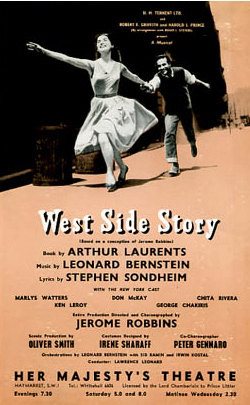
Version 1
West Side Story (1958-12-Her Majesty's Theatre-London)
Type de série: Original LondonThéâtre: Her Majesty's Theatre (Londres - Angleterre) Durée : Nombre : 1039 représentationsPremière Preview : 12 December 1958
Première: 12 December 1958
Dernière: InconnuMise en scène : Jerome Robbins • Chorégraphie : Jerome Robbins • Producteur : Star(s) : Avec: George Chakiris (Riff), Don McKay (Tony), Eddie Roll (Action), Tony Mordente (A-Rab), Ed Verso (Baby John), Riggs O'Hara (Snowboy), David Bean (Big Deal), Gary Cockrell (Diesel), Michael Kleinman (Gee-Tar), Joe Donovan (Mouthpiece)

Version 2
West Side Story (1964-04-City Center-New York)
Type de série: RevivalThéâtre: City Center (New-York - Etats-Unis) Durée : 3 semaines Nombre : 31 représentationsPremière Preview : 08 April 1964
Première: 08 April 1964
Dernière: 03 May 1964Mise en scène : Gerald Freedman • Chorégraphie : Tom Abbott • Producteur : Star(s) :
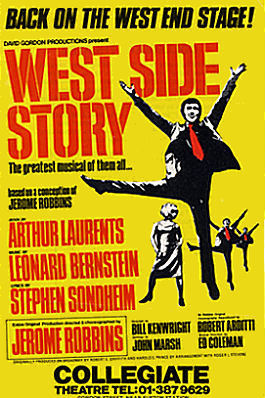
Version 3
West Side Story (1973-07-Collegiate Theatre-London)
Type de série: RevivalThéâtre: Bloomsbery Theatre (Londres - Angleterre) Durée : Nombre : Première Preview : 03 July 1973
Première: 03 July 1973
Dernière: InconnuMise en scène : Bill Kenwright • Chorégraphie : Robert Arditti • Producteur : Star(s) : Avec: Tony ... Jim Smilie / Maria ... Rosamund Shelley / Riff ... Roger Finch / Diesel ... Michael Howe / Bernardo ... Peter Daly / Anita ... Clovissa NewcombeCommentaires longs: Cette production jouée au Collegiate Theatre (actuellement le Bloomsbury Theatre) est le passage à Londres d'un très long UK Tour issu de la version originale londonienne jouée au Her Majesty’s en décembre 1968.
Elle reviendra à Londres une nouvelle fois en 1974 au Shaftesbury Theatre

Version 4
West Side Story (1974-12-Shaftesbury Theatre-London)
Type de série: RevivalThéâtre: Shaftesbury Theatre (Londres - Angleterre) Durée : Nombre : Première Preview : 19 December 1974
Première: 19 December 1974
Dernière: InconnuMise en scène : Bill Kenwright • Chorégraphie : Roger Finch • Producteur : Star(s) : Avec: Lionel Morton (Tony), Christiana Matthews (Maria), Roger Finch (Riff), John Alisdair (Diesel), Paul Hart (Bernardo), Petra Siniawski (Anita)Commentaires : Il s'agit du premier spectacle présenté au Shaftesbury après l'effondrement du plafond le 20 juillet 1973 lors des représentations de 'Hair'.
Se joue jusqu'à l'été 1975.
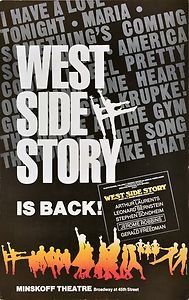
Version 5
West Side Story (1980-02-Minskoff Theatre-Broadway)
Type de série: RevivalThéâtre: Minskoff Theatre (Broadway - Etats-Unis) Durée : 9 mois 2 semaines Nombre : 8 previews - 333 représentationsPremière Preview : 07 February 1980
Première: 14 February 1980
Dernière: 30 November 1980Mise en scène : Jerome Robbins • Chorégraphie : Jerome Robbins • Producteur : Star(s) : Avec: James J. Mellon (Riff), Ken Marshall (Tony), Mark Bove (Action), Todd Lester (A-Rab), Brian Kaman (Baby John), Cleve Asbury (Snowboy), Reed Jones (Big Deal), Brent Barrett (Diesel), G. Russell Weilandich (Gee-Tar), Stephen Bogardus (Mouth Piece)
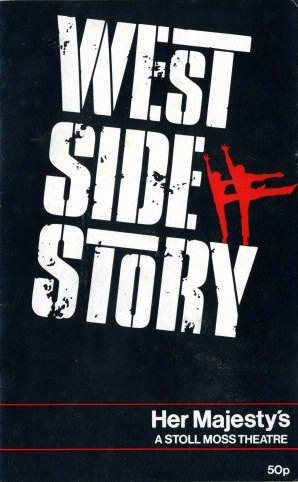
Version 6
West Side Story (1984-05-Her Majesty's Theatre-London)
Type de série: RevivalThéâtre: Her Majesty's Theatre (Londres - Angleterre) Durée : 1 an 4 mois 2 semaines Nombre : Première Preview : 16 May 1984
Première: 16 May 1984
Dernière: 28 September 1985Mise en scène : Jerome Robbins • Tom Abbott • Chorégraphie : Jerome Robbins • Tom Abbott • Producteur : Star(s) : Avec: Steven Pacey (Tony), Jan Hartley (Maria), Richard Pettyfer (Riff), Sam Williams (Bernardo), Lee Robinson (Anita), David Morris (ii) (Chino), Adam Matalon (Action), Peter Leeper (A-Rab), Ian Embleton (Baby John), Garry Noakes (Snowboy)Commentaires : This production had originated at Leicester Haymarket and opened in December 1983. It had been on a UK tour which culminated in a West End season from May 1984 to October 1985. Later cast changes saw Peter Bruce and Karyn O’Neill take over the leads.
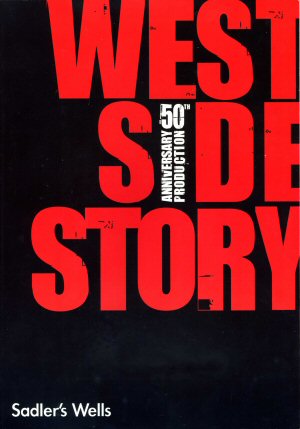
Version 7
West Side Story (2008-07-Sadler's Wells Theatre-London)
Type de série: RevivalThéâtre: Sadler's Wells (Londres - Angleterre) Salle : TheatreDurée : 1 mois 1 semaine Nombre : Première Preview : 22 July 2008
Première: 24 July 2008
Dernière: 31 August 2008Mise en scène : Joey McKneely • Chorégraphie : Joey McKneely • Producteur : Star(s) : Avec: Ryan Silverman/Scott Sussman ( Tony), Elisa Cordova/Sofia Escobar (Maria ), Leo Ash Evans (Riff), V ictor James Wisehart (Diesel), Alana Gordon/Oneika Phillips (Anita) , Marco Santiago (Bernardo), Steven Greenstein, Julian Alvarez, Sara DobbsCommentaires : This production played a short season in London, following dates in Tokyo, Paris and Beijing. With a cast of 40 and large orchestra, this was an international celebration of the show’s 50 th anniversary. The critics were delighted to report it was as powerful, dramatic and exciting as ever, though several felt the “dream ballet” sequence for the “Somewhere” number was the only give-away of the show’s age – the only part of the show that felt dated and seriously out of place.Commentaires longs: 21 Juillet 09 au 25 Juillet 09 - The Lowry, Salford
14 Juillet 09 au 18 Juillet 09 - Milton Keynes Theatre, Milton Keynes
30 Juin 09 au 11 Juillet 09 - Hippodrome, Bristol
16 Juin 09 au 27 Juin 09 - Regent Theatre, Stoke - on - Trent
2 Juin 09 au 13 Juin 09 - Lyceum Theatre, Sheffield
19 Mai 09 au 30 Mai 09 - His Majesty's Theatre, Aberdeen
5 Mai 09 au 16 Mai 09 - Festival Theatre, Edinburgh
21 Avril 09 au 2 Mai 09 - Birmingham Hippodrome, Birmingham
14 Avril 09 au 18 Avril 09 - New Victoria Theatre, Woking
31 Mars 09 au 11 Avril 09 - Theatre Royal, Nottingham
17 Mars 09 au 28 Mars 09 - Grand Theatre and Opera House, Leeds
10 Mars 09 au 14 Mars 09 - New Wimbledon Theatre, Outer London
24 Février 09 au 7 Mars 09 - Wycombe Swan, High Wycombe
10 Février 09 au 21 Février 09 - Theatre Royal, Newcastle upon Tyne
27 Janvier 09 au 7 Février 09 - Mayflower Theatre, Southampton
6 Janvier 09 au 17 Janvier 09 - Wales Millennium Centre, Cardiff
11 Novembre 08 au 29 Novembre 08 - Theatre Royal, Glasgow
14 Octobre 08 au 1 Novembre 08 - New Wimbledon Theatre, Outer London
30 Septembre 08 au 11 Octobre 08 - The Lowry, Salford
16 Septembre 08 au 27 Septembre 08 - Milton Keynes Theatre, Milton Keynes
2 Septembre 08 au 13 Septembre 08 - New Victoria Theatre, Woking
22 Juillet 08 au 31 Août 08 - Sadler's Wells Theatre
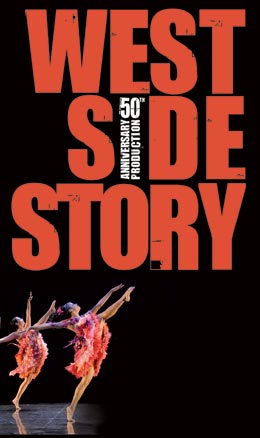
Version 8
West Side Story (2008-09-UK Tour)
Type de série: UK TourThéâtre: UK Tour ( - Angleterre) Durée : 10 mois 3 semaines Nombre : Première Preview : 02 September 2008
Première: 02 September 2008
Dernière: 25 July 2009Mise en scène : Joey McKneely • Chorégraphie : Joey McKneely • Producteur : Star(s) : Avec: Ryan Silverman/Scott Sussman ( Tony), Elisa Cordova/Sofia Escobar (Maria ), Leo Ash Evans (Riff), V ictor James Wisehart (Diesel), Alana Gordon/Oneika Phillips (Anita) , Marco Santiago (Bernardo), Steven Greenstein, Julian Alvarez, Sara DobbsCommentaires : This production played a short season in London, following dates in Tokyo, Paris and Beijing. With a cast of 40 and large orchestra, this was an international celebration of the show’s 50 th anniversary. The critics were delighted to report it was as powerful, dramatic and exciting as ever, though several felt the “dream ballet” sequence for the “Somewhere” number was the only give-away of the show’s age – the only part of the show that felt dated and seriously out of place.
Dates du tourCommentaires longs: 21 Juillet 09 au 25 Juillet 09 - The Lowry, Salford
14 Juillet 09 au 18 Juillet 09 - Milton Keynes Theatre, Milton Keynes
30 Juin 09 au 11 Juillet 09 - Hippodrome, Bristol
16 Juin 09 au 27 Juin 09 - Regent Theatre, Stoke - on - Trent
2 Juin 09 au 13 Juin 09 - Lyceum Theatre, Sheffield
19 Mai 09 au 30 Mai 09 - His Majesty's Theatre, Aberdeen
5 Mai 09 au 16 Mai 09 - Festival Theatre, Edinburgh
21 Avril 09 au 2 Mai 09 - Birmingham Hippodrome, Birmingham
14 Avril 09 au 18 Avril 09 - New Victoria Theatre, Woking
31 Mars 09 au 11 Avril 09 - Theatre Royal, Nottingham
17 Mars 09 au 28 Mars 09 - Grand Theatre and Opera House, Leeds
10 Mars 09 au 14 Mars 09 - New Wimbledon Theatre, Outer London
24 Février 09 au 7 Mars 09 - Wycombe Swan, High Wycombe
10 Février 09 au 21 Février 09 - Theatre Royal, Newcastle upon Tyne
27 Janvier 09 au 7 Février 09 - Mayflower Theatre, Southampton
6 Janvier 09 au 17 Janvier 09 - Wales Millennium Centre, Cardiff
11 Novembre 08 au 29 Novembre 08 - Theatre Royal, Glasgow
14 Octobre 08 au 1 Novembre 08 - New Wimbledon Theatre, Outer London
30 Septembre 08 au 11 Octobre 08 - The Lowry, Salford
16 Septembre 08 au 27 Septembre 08 - Milton Keynes Theatre, Milton Keynes
2 Septembre 08 au 13 Septembre 08 - New Victoria Theatre, Woking
22 Juillet 08 au 31 Août 08 - Sadler's Wells Theatre
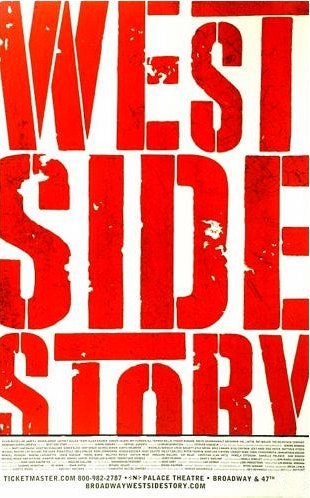
Version 9
West Side Story (2009-02-Palace Theatre-Broadway)
Type de série: RevivalThéâtre: Palace Theatre (Broadway - Etats-Unis) Durée : 1 an 9 mois 2 semaines Nombre : 27 previews - 748 représentationsPremière Preview : 23 February 2009
Première: 19 March 2009
Dernière: 02 January 2011Mise en scène : Arthur Laurents • Jerome Robbins • Chorégraphie : Jerome Robbins • Producteur : Star(s) : Avec: Matt Cavenaugh (Tony), Josefina Scaglione (Maria), George Akram (Bernardo), Cody Green (Riff), Karen Olivo (Anita), Nicholas Barasch (Kiddo (alt.)), Steve Bassett (Lt. Schrank), Kyle Brenn (Kiddo (alt.)), Joshua Buscher (Diesel), Isaac Calpito (Inca)

Version 10
West Side Story (2010-07-Freilichtspiele-Tecklenburg)
Type de série: RevivalThéâtre: Freilichtspiele Tecklenburg (Tecklenburg - Allemagne) Durée : 1 mois 1 semaine Nombre : Première Preview : 23 July 2010
Première: 23 July 2010
Dernière: 04 September 2010Mise en scène : Helga Wolf Wolf • Chorégraphie : Doris Marlis • Producteur : Star(s) : Avec: Lucius Wolter (Tony), Leah Delos Santos (Maria), Lars Kemter (Riff), Gianni Meurer (Bernardo), Sigrid Brandstetter (Anita), Jana Stelley (Anybody's), Hannes Demming (Doc), Stefan Poslovski (Officer Krupke), Michael Schüler (Gladhand), Michael Micheiloff (Schrank), Martin Kiuntke (Action), Harald Tauber (Diesel), Stephan Luethy (Baby John), Nils Haberstroh (Snowboy), Kristian Lucas (Professor), Silvano Marraffa (Chino), Tom Schimon (Ensemble Jets), Jörn Ortmann (Ensemble Jets), Andrew Hill (Ensemble Jets), Philipp Georgopoulos (Ensemble Jets), Anke Merz (Ensemble Jets), Juliane Bischoff (Ensemble Jets), Silja Schenk (Ensemble Jets), Marthe Römer (Ensemble Jets), Sophie Blümel (Ensemble Jets), Esther-Larissa Lach (Ensemble Jets), Jessica Krüger (Ensemble Jets), Daniel Ruiz (Ensemble Sharks), Kevin Foster (Ensemble Sharks), Julian Sylva (Ensemble Sharks), Marius Hatt (Ensemble Sharks), Jan Altenbockum (Ensemble Sharks), Hakan T. Aslan (Ensemble Sharks), Raphaela J. Gross-Fengels (Ensemble Sharks), Angela Hunkeler (Ensemble Sharks), Michelle Escano (Ensemble Sharks), Janina Keppel (Ensemble Sharks), Rachel Colley (Ensemble Sharks), Rebecca Stahlhut (Ensemble Sharks), Laura Fernandez (Ensemble Sharks)
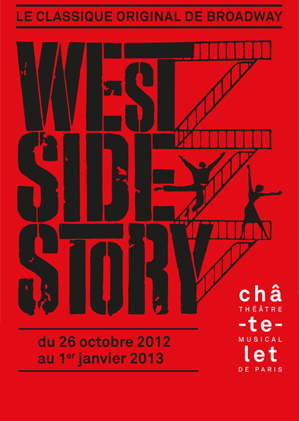
Version 11
West Side Story (2012-10-Théâtre du Châtelet-Paris)
Type de série: RevivalThéâtre: Théâtre du Châtelet (Paris - France) Durée : 2 mois 1 semaine Nombre : 81 représentationsPremière Preview : 26 October 2012
Première: 26 October 2012
Dernière: 01 January 2013Mise en scène : Jerome Robbins • Joey McKneely • Chorégraphie : Jerome Robbins • Joey McKneely • Producteur : Star(s) : Avec: Chris Behmke / Liam Tobin (Tony), Elena Sancho Pereg / Diana Rose Becker (Maria), Yanira Marin(Anita), Andy Jones (Riff), Pepe Munoz (Bernardo), Joe Gioco (Doc), Joe Wojda (Shrank), Mel Shrawder (Krupke), James Michael Reilly (Glad Hand)
The Jets : Rhett Aren Gutter, Brandon Hudson, Michael Bullard, Fred P. Odgaard, Ryan Fitzgerald, Drew Nellessen, Nicholas Sipes, Ryan Ghysels, Tenealle Ferragher, Addie Tomlinson, Courtney Ortiz, Sarah Blodgett, Melanie A. Wildman, Christie Partelow
The Sharks : Nikko Kimzin, Christian Elan Ortiz, Caleb Teicher, Michael Juan Bishop, Charles South, Jerimy Luis Rivera, Armando Reinaldo Yearwood Jr, Maria Victoria Failla, NaTonia Monét, Natalie Williams, Kara Anne Duncan, Emma Sofia Pfaeffle, Naomi C. Walley
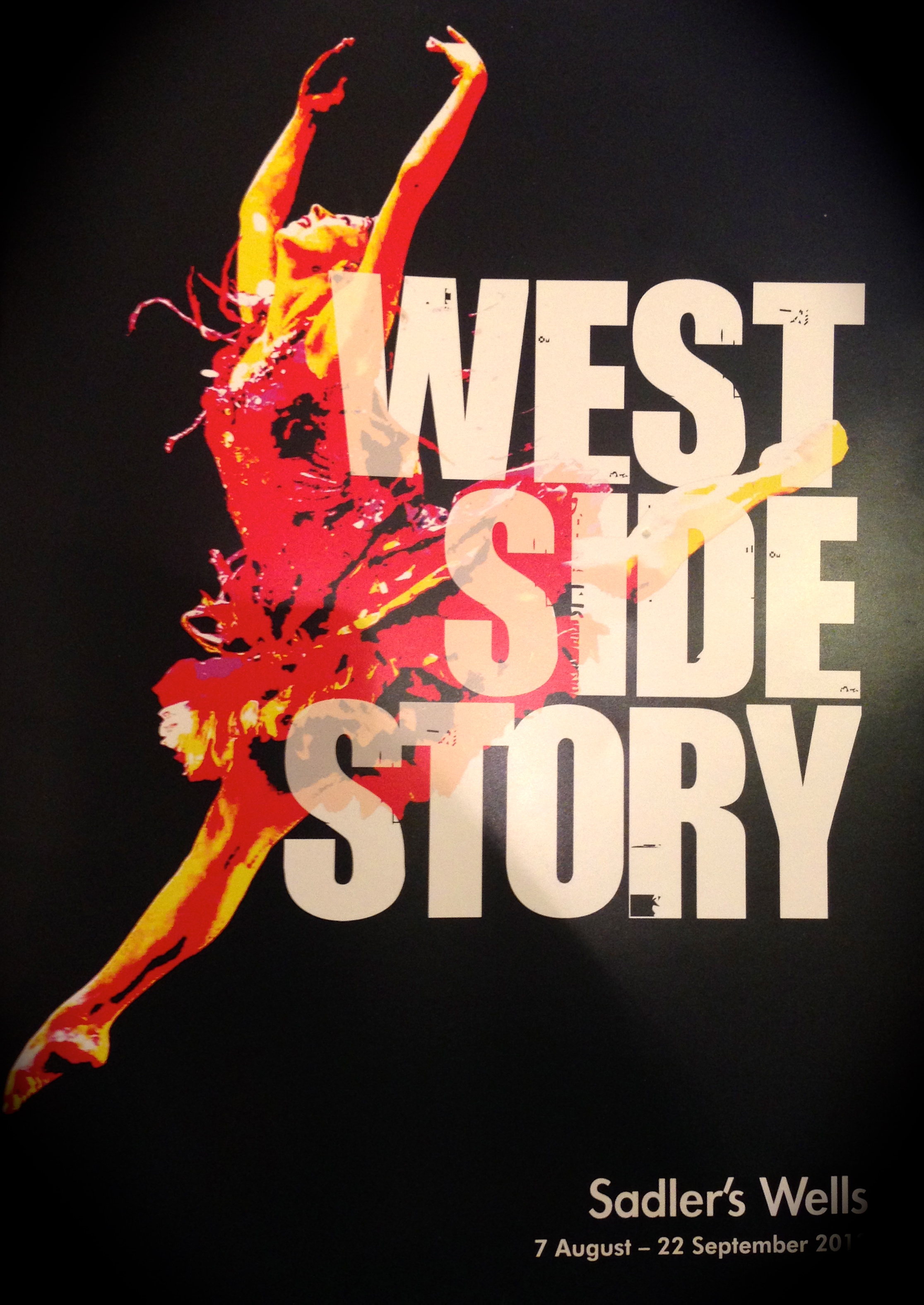
Version 12
West Side Story (2013-08-Sadler's Wells Theatre-London)
Type de série: RevivalThéâtre: Sadler's Wells (Londres - Angleterre) Salle : TheatreDurée : 1 mois 2 semaines Nombre : Première Preview : 07 August 2013
Première: 07 August 2013
Dernière: 22 September 2013Mise en scène : Joey McKneely • Chorégraphie : Joey McKneely • Producteur : Star(s) : Presse : **** "Still as gloriously fresh, relevant and thrilling as ever"
TIME OUT
**** "If you buy one theatre ticket this summer, make it this one. A thrilling, hurtling triumph"
THE OBSERVER
Pas encore de video disponible pour ce spectacle
